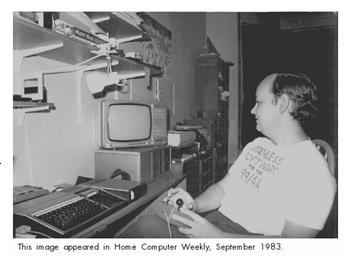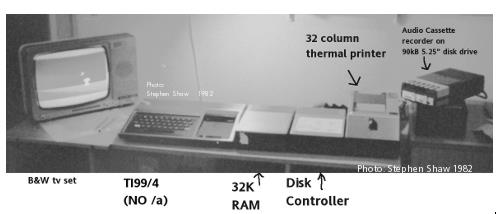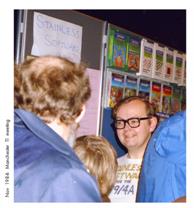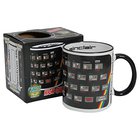|
This article was contributed by Stephen Shaw in 2013. * Stephen Shaw - Author of "Getting Started with the Texas Instruments TI-99/4A", proprietor of "Stainless Software", founder member of the first UK TI99/4A Users Group, first UK winner of Edgar Mauk Award (2000), first UK entrant into TI99ers Hall of Fame (2013).....
The television is sitting on the "Peripheral Expansion Box" which took the place of the long daisy chain of separate expansion devices. An initial hobbyist interest in electronics from 1964... building valve radios. First use of "computers" from 1970 using an IBM mainframe remotely using a keyboard with a dual golf-ball head printer: NO VDU or display screen. One printer head used for data input, the other printer head used for query input and output. Early takeup of LED digital watch; do-it-yourself 5-game games computer; Sinclair Cambridge Programmable Calculator. None of these was especially successful. I made a note in August 1980 which records "TI- long record of advanced technology, also long record of poor marketing" - yep. Spot on. By September 1980 I was looking to buy one of the new fangled home computers, still quite expensive and restricted both. I wrote to Texas Instruments then in Bedford on 23/9/80 seeking more technical information on their announced TI99/4 computer and a UK version with PAL modulated tv output.. In a letter dated 13/10/80 TI advised: PAL output due 1981; no ram expansion planned; price includes one days tuition; Paul Dicks was starting a User Group. My correspondence with TI included letters from their Marketing Manager and their Product Manager- few companies then (especially now!) would correspond at such a level. It is unfortunate that internal secrecies meant much of what they wrote was inaccurate. About this time I had the loan from TI in Manchester of an NTSC TI99/4 console and NTSC monitor and made good progress on writing a personal double entry ledger program for my own use (it continued in use until 1998!). How many technology companies today would do this? I have a pro forma invoice from TI dated 27/6/81 for GBP 1705 for a TI99/4 (the predecessor of the TI99/4a), with 32k ram expansion, 32 column thermal printer, single 5.25 inch floppy drive (capacity a mere 90 kB), and three modules. Now allow for inflation to see how that works out in 2012 prices... GBP 5,300. Wow. You can buy a LOT of computer for that in 2013.
Of course, my TI99/4a does still work after 30 years.... (but will be unuseable when we can't buy a tv or tuner for analogue channel 36). The thermal printer was an expensive mistake, once the initial supply of paper ran out, no more was available and the print faded very quickly. Not that it was ever easy to read. It was too quickly replaced by yet another big box the same size as the 32k ram, this time an RS232 interface, which was joined by an Epson FX80 printer - which is still in use in 2013, some 30 years later. They knew how to make printers back then. Initial fully expanded TI rig - with quite rare TI99/4 (no A yet) and the 32 column thermal printer. It looks like I joined the user group before I actually had ownership of the PAL output TI99/4. The first issue of TI Home, the quarterly magazine of the first UK User Group, dated February 1981 was entirely by Paul Dicks. In the second and third issues there were very brief pieces by myself and Peter Brooks. In issue 4 there was nothing from me but a very long article by Peter. Issue four had a list of members- total 19 members. From Issue 5 both myself and Peter were regular contributors. The last contribution I can trace making to the UK User group was around 1999. In the earlier years I had several Basic listings published in the magazine Computer and Video Games, and also contributed articles to Personal Computer News. In later years my articles were published in the American commercial TI99/4a magazine Micropendium, and also in the User Group magazine of the Sydney (Australia) user group. As time went on membership grew and life became hard for Paul Dicks to manage it on his own. TI and Paul passed the membership on to a "professional" public relations firm just before TI stopped producing the TI99/4a in November 1983. They produced five copies of an 8 page newsletter. The more technically literate members of Paul's group joined a new group started by Clive Scally. I contributed to his magazine TI*MES, from Issue 2. Clive ran TI*MES Winter 1983 up to May 1987, when he passed membership on to a "club" organisation. 1982/3- I started writing programs. Wanted to buy programs- There was a lack of software for the TI, I was buying it from America and saw no reason it could not be sold here. In the absence of anyone else, I obtained licences from the copyright owners and Stainless Software was born, slowly growing with more licences and the addition of UK written programmes. (Afterwards, the late Ian Martin of Timeless Software also sold American programmes). I like to think I had the first software licence from Waddingtons Games (remember them? They originally sold Cluedo and Monopoly in the UK)- I have a license from them dated 25/3/1982 for their game Black Box invented by Dr Eric Solomon. I first wrote to US publishers asking for licences in March 1982. I wrote to Not Polyoptics in June 1982- they had a range of simple logic programmes that proved quite popular. I found that some programs had been on sale in America for some time which contained little programming errors, which I corrected and fed back to the originator. There was also an interesting technical problem with American programs written in Extended Basic: on European PAL consoles, sprites moved slightly faster than on NTSC American consoles, and I sometimes had to adjust program code to make games play properly. One American software author I paid small sums of money to was Mark Sumner, a young man who was doing a lot of jobs to raise the funds to take time out to write some science fiction books, with one series published by Del Rey and one by Ace - so I was also sponsoring a literary creator! Another programmer I assisted was William (Bill) Kuhl who has now found fame if not fortune on the internet as scienceguy.org. The magazine Home Computer Weekly published a full page article about Stainless Software in the issue of 6th September 1983. I set my software retail prices at a level equivalent to other software on sale at the time, and chose to offer what was probably a high level of royalty to the writers, up to 35% of gross retail. Due to international tax rules I also had to deduct UK income tax from royalty payments sent overseas, and pay that over to H M Collector of Taxes. Retailers needed a discount of course! and later on VAT was to take a cut. I operated part time, and never planned on profits- just ploughing back any surplus in new equipment, and investigating software and hardware for review, purchase, or licensing. There was advertising to pay for, blank tapes, documentation, packaging. Stainless Software did grow large enough to have to register for sales tax - based upon turnover, not profit - , but only for a short period, as by November 1983 TI had nearly been brought to its knees with losses on the computer and ceased production. There was then an unseemly scramble to pick up game modules before they disappeared, and sales of programs on tape all but disappeared. The last sale from Stainless was in October 1985. Stainless was also big enough to attract the attention of commercial pirates, and a number of pirate tapes were seized in Scotland. No other TI software supplier admitted to piracy of their product. My early involvement with the TI led to my being approached by a book publisher who wanted a TI99/4a book on the shelves. So in Summer of 1983 I wrote Getting Started with the TI99/4A, which was published by Phoenix Publishing. I was paid an advance up front and altogether probably received a couple of thousand pounds. Alas because I was registered for sales tax, my receipts were taxed for sales tax AND for income tax - books have no value added tax, but supplying authorial services is taxable It was cool to see my name on book shop shelves, and to have my book in libraries. It was even sold in Australia. And the text is now freely available on the web- although the actual book was still listed on Amazon.co.uk when I looked in 2013. November 1984 was the first national meeting of UK TI99/4a users, in the Ritz Ballroom in Manchester, with several merchants and a very large number of TI99/4a users coming to get goodies. Stainless had a tiny corner of a stand run by Arcade Hardware (run by Howard Greenberg) but tape sales were tiny. Using a rented video recorder, samples of Stainless games were played continuously through the show, but I'm not sure anyone noticed - the videotapetape had been copied for me by a local retailer at no cost. My six month old son was present for this historic occaision, but does not remember it. Around June/July 1985 I purchased a complete set of public domain software from Guy Stefan-Romano, and made this the basis of a disk based library offered to members of TI*MES which at this time was a sole proprietorship of Clive Scally - so the Disk Library was basically me. When Stainless Software ceased, I requested all the UK programmers whose programs Stainless distributed to release their programmes to the disk library and most of them agreed. The collection then grew with major additions from Jim Peterson in America and other user groups and personal contacts with programmers. Stainless? One customer guessed. Just one. My gran had told me of a music hall act - called Stainless Stephen. When the user group passed to communal hands, the Disk Library paid over surplus funds to the group's central fund - I have a note of GBP 300 being passed on in 1989. The last recorded supply from the disk library was April 1993. Dealing so much with America I found a number of pen friends and wrote to many of the TI greats. I exchanged letters with Ray Kazmer for maybe 15 years, as well as programs, and biscuits (Ray sent Oreo Cookies, we sent Jaffa Cakes, made here in Heaton Chapel, Stockport). Ray also sent my son a cuddly Garfield and a cuddly Odie. Ken Gilliland (Notung Software and commercial artist) was a friend of Ray's and we exchanged programs with Ken also. Guy Stefan Romano took care of the Amnion Software Library, and we were able to send him a Kenwood Beater for his mixer at well below any price he could find- he sent lots of TI stuff and a copy of a recipe book he had written. Jim Peterson was a great TI supporter, writing monthly articles for user groups, publishing a huge amount of software and finally collecting together TI shareware/public domain programs. I consider myself privileged to have been a part of a great community. By the end of the 20th Century, a group of national European TI User Groups had banded together to hold a single European get together, the Treffen, held in different countries each year. In October 2000, I was awarded an "Edgar Mauk Award" in Ghent, "for remarkeble achievements in the TI-hobby made by European TI-users." in the category "Userservice" "for the support of the British TI-community.". The awards only started in 2000, with initially five awards given, and in 2000 I was the only Brit. European interest in the computer seemed to be heavily hardware oriented, with much independent hardware being produced - such as a mouse for example. Unfortunately this all required someone to write programs to use it, and such programs were not there. My interest in developing new hardware was not great. I did test a US made light pistol (for games) and purchased a German mouse, but neither was used. I tested an early independent UK joystick which used real microswitches, and had a metal shaft- that got used. In its later TI years (1983/4) the TI99/4a received an advanced games peripheral (referred to as an MBX Unit) which had a touch pad and speech recognition, and many games modules that could use it - this was one of the rarer pieces of hardware which saw regular use in our household, the educational side was well designed. I also tried out a sketch pad which used a pantograph like affair to trace images onto the screen- that had some major drawbacks in terms of saving / printing. I was privileged to see a real in-the-flesh Thorn-EMI module made for the TI99/4a. Although the module was never released, after some years the three Thorn modules did see the light of day from an independent trader, properly licensed, on disk. The presumably prototype module I saw was designed- unusually- to plug into the side of the computer, not the usual module slot at the front. Inside it used an unusual white ceramic chip mounted directly onto the PCB, no black plastic coating. My son was born into a house with a computer, and programming was just another language skill he learned. He is now a software developer. Back in 1995 I commented upon buying a PC that my TI would outlive it - and it did. The 1995 first PC died in 2002, whilst my TI is still operational. Subsequent to 1999 when my contacts with the UK TI Community fell away, my computer work at home has been on the now standard PC, but after Windows 98 I have switched to using Linux systems at home, with the sdlbasic programming language allowing me to continue to play with tiny graphics programs, which ran so very much more slowly on the TI99/4a. My TI99/4a remains in working order, and additionally I have four TI emulators to run on the PC. In 2013 I was the first UK inductee into the TI99ers Hall of Fame - founded 2004, I was the 39th entrant. I was made redundant from my job in 2003, but found another job in a completely different field and finally retired in 2010. In my final years of work I put in a few hours a week digitising images for our local library, and now spend my time online adding details to the "Britain from Above" digital collection.
Stephen Shaw at the first National UK TI99/4a users meeting in Manchester in November 1984. Date : 7th October 2013 This exhibit has a reference ID of CH31277. Please quote this reference ID in any communication with the Centre for Computing History. |
|



























